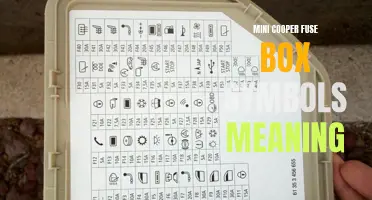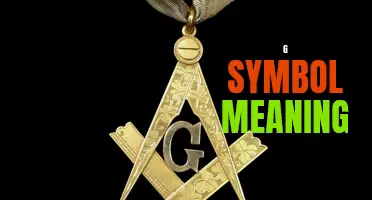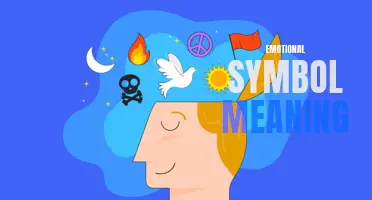
Diwali, also known as the Festival of Lights, is one of the most widely celebrated festivals in India and holds a significant cultural and spiritual meaning. At the heart of this joyous occasion are the vividly colorful symbols that light up homes, temples, and streets, creating an alluring ambiance that captures the essence of Diwali. From the lighting of diyas, oil lamps, to the intricate patterns of rangoli, the festival's symbols are deeply rooted in the ancient traditions and legends that add depth and enchantment to the celebration. So let's dive deeper into the mesmerizing world of Diwali symbols and uncover their profound meanings and cultural significance.
What You'll Learn
- What are some common symbols associated with Diwali?
- What is the significance of the Diya in Diwali celebrations?
- How are rangoli designs used as symbols in Diwali?
- What is the role of fireworks as symbols in Diwali?
- Are there any specific flowers or garlands that hold symbolic meaning in Diwali celebrations?

What are some common symbols associated with Diwali?
Diwali, also known as the Festival of Lights, is one of the most important festivals in Hinduism. It is celebrated with great fervor and joy by millions of people around the world. This festival signifies the victory of light over darkness and good over evil. There are several symbols associated with Diwali that hold deep cultural and religious significance. Here are some common symbols that are an integral part of the Diwali celebrations:
- Diyas: Diyas, or oil lamps, are perhaps the most prominent symbol of Diwali. These small clay lamps are lit with oil or ghee and a cotton wick. They are placed outside homes, in courtyards, and along pathways to create a beautiful and warm atmosphere. The lighting of diyas represents the inner light that protects from spiritual darkness.
- Rangoli: Rangoli is a decorative art form that involves creating beautiful patterns and designs on the floor using colored powders, rice, or flower petals. During Diwali, homes and courtyard entrances are adorned with intricate rangoli designs to welcome Lakshmi, the goddess of wealth and prosperity. Rangoli is believed to bring good luck and ward off negative energies.
- Fireworks: Fireworks are a common sight during Diwali celebrations. Bursting crackers and lighting fireworks is a way of celebrating the victory of good over evil and expressing joy and excitement. The loud noise and bright lights are believed to drive away evil spirits and bring happiness and prosperity.
- Toran: A toran is a decorative hanging made of flowers, leaves, or beads that is hung on the entrance of homes during Diwali. It is considered auspicious and is believed to attract positive energy and bring good luck. Torans are often made with marigold flowers, mango leaves, or other auspicious materials symbolizing fertility and abundance.
- Sweets and Mithai: Diwali is also a time for indulging in delicious sweets and mithai. Exchange and sharing of sweets is a common practice during this festival. It symbolizes spreading happiness and sweetness in one's life and relationships.
- The Swastika: The swastika is a symbol of good luck and prosperity in Hinduism. It is believed to bring good fortune and positive energy when used in religious and cultural ceremonies. During Diwali, the swastika symbol is often drawn on the floor or made with flowers to welcome the goddess Lakshmi and invoke her blessings.
These symbols play a significant role in Diwali celebrations, as they represent the underlying spiritual and cultural values associated with the festival. Diwali is a time for people to come together, celebrate, and spread joy and happiness. The bright lights, colorful decorations, and delicious food create an atmosphere of warmth and positivity, making Diwali a truly special and memorable festival.

What is the significance of the Diya in Diwali celebrations?
Diwali, also known as the Festival of Lights, is one of the most significant festivals celebrated in India and among the Indian diaspora worldwide. The festival marks the victory of light over darkness and good over evil. During Diwali, people illuminate their homes and surroundings with bright lights and colorful decorations. One vital element that holds considerable significance in Diwali celebrations is the Diya.
A Diya is a small, oil-filled lamp made of clay, usually with a cotton wick dipped in ghee or oil. These lamps are lit to symbolize the elimination of darkness and the spread of light and positivity. The Diya is an essential part of Diwali as it represents the spiritual awakening and the triumph of knowledge over ignorance. Lighting Diyas is believed to bring blessings and good fortune into one's life.
The lighting of Diyas during Diwali also holds religious and cultural significance. According to Hindu mythology, Lord Rama, along with his wife Sita and younger brother Lakshmana, returned to Ayodhya after 14 years of exile and defeating the demon king Ravana. The residents of Ayodhya celebrated their return by lighting thousands of Diyas to welcome them and symbolize the victory of good over evil.
Furthermore, the Diya is believed to attract positive energies and ward off negative influences. It is believed that the light emitted by the Diya helps in dispelling negativity and purifying the surroundings. Lighting Diyas is also seen as a way to invite the deities and seek their blessings. It is believed that the light of the Diya drives away darkness, both literally and metaphorically, bringing spiritual enlightenment and inner peace.
In addition to its religious and spiritual significance, the Diya has also become a symbol of unity and togetherness during Diwali. Families come together to light Diyas and create beautiful patterns or designs, known as Rangoli, using colored powders, rice, or flower petals around the Diyas. This collective effort not only adds to the festive spirit but also strengthens family bonds and fosters a sense of community.
The traditional Diya has evolved over time, and now there are various stylish and decorative Diyas available in the market. People choose Diyas of different shapes, sizes, and colors to add a touch of elegance and creativity to their Diwali celebrations. However, the humble clay Diya continues to be the most popular and cherished form as it maintains the traditional essence and connection to the earth.
In conclusion, the Diya holds immense significance in Diwali celebrations. It represents the victory of light over darkness, good over evil, knowledge over ignorance, and brings blessings, positivity, and good fortune. Lighting Diyas during Diwali not only illuminates physical spaces but also symbolizes the inner light within each individual, fostering a sense of unity, togetherness, and spiritual awakening.
Unveiling the Hidden Symbolism and Meaning of Mushrooms
You may want to see also

How are rangoli designs used as symbols in Diwali?
Rangoli designs are an integral part of Diwali celebrations in India. They are beautiful and intricate patterns made on the floor using colorful powders, flowers, or rice. Rangoli designs hold significant cultural and symbolic importance in Diwali, the festival of lights. Let's explore how rangoli designs are used as symbols in Diwali.
Diwali, also known as Deepavali, is a Hindu festival celebrated across India and several other countries. It signifies the victory of light over darkness and good over evil. People decorate their homes with diyas (oil lamps) and lights to symbolize the triumph of light. Rangoli designs play a crucial role in this decoration process and hold deep cultural significance.
One of the primary functions of rangoli designs during Diwali is to invite prosperity and good luck into the home. The intricate patterns are believed to welcome Goddess Lakshmi, the goddess of wealth and prosperity. It is widely believed that by creating rangoli designs at the entrance of the home, one can attract good fortune and blessings.
Moreover, rangoli designs are considered an expression of creativity and artistic skills. They showcase the rich cultural heritage of India. Different regions have their distinct styles and patterns of rangoli. The designs often depict gods, goddesses, flowers, birds, and other natural elements. The choice of colors and motifs varies based on personal preferences and regional traditions.
Rangoli designs also symbolize unity and togetherness. During Diwali, families come together to create rangoli designs. It is a collaborative effort that strengthens family bonds and fosters a sense of belonging. The colors and patterns used in the rangoli reflect the harmonious coexistence of nature and humanity.
Another symbol represented by rangoli in Diwali is the celebration of life and harmony. The circular shapes and patterns often found in rangoli represent the cyclical nature of life, the eternal cycle of birth and rebirth. It is a reminder to embrace change and find harmony in life's ups and downs.
Furthermore, rangoli designs also have a spiritual significance during Diwali. They are believed to ward off evil spirits and negativity from the home. The intricate patterns act as a protective shield, creating a positive and sacred environment during the festive season. Rangoli is seen as a spiritual art form that brings positive energy and uplifts the atmosphere.
In conclusion, rangoli designs are much more than just decorative patterns during Diwali. They symbolize auspiciousness, creativity, unity, harmony, and spirituality. Creating rangoli designs not only adds beauty to the festive celebrations but also reinforces the cultural values and traditions associated with Diwali. It is a meaningful way to connect with the essence of the festival and celebrate the triumph of light and goodness.
The Complete Guide to Cadillac Escalade Dashboard Symbols and Meanings
You may want to see also

What is the role of fireworks as symbols in Diwali?
Diwali, also known as the Festival of Lights, is one of the most prominent and widely celebrated Hindu festivals. It is observed by millions of people across the globe, and its main festivities include lighting oil lamps (diyas), exchanging gifts, sharing sweets, and bursting fireworks. Fireworks play a significant role in the celebration of Diwali, serving as symbols of joy, light, and the triumph of good over evil.
In Hindu mythology, Diwali marks the return of Lord Rama after 14 years of exile and his victory over the demon king Ravana. To welcome Lord Rama back to Ayodhya, the citizens lit oil lamps and burst fireworks to spread light and eradicate darkness. Thus, bursting fireworks during Diwali is seen as a way to commemorate this historic event and express happiness and gratitude.
Fireworks also serve as a symbol of victory. The bursting of firecrackers symbolizes the victory of good over evil and light over darkness. It is believed that by lighting fireworks, people are driving away negative forces and welcoming positive energy into their lives. The sound and light produced by the fireworks are believed to scare away evil spirits and demons.
Furthermore, fireworks are regarded as a way to ward off bad luck and bring prosperity. It is believed that the loud noise and bright lights of fireworks scare away negative energies and bring good fortune for the coming year. Bursting fireworks is seen as a way to start the new year on an auspicious note and bring wealth and success.
In addition to their symbolic significance, fireworks during Diwali also add to the festive atmosphere and create a sense of excitement and joy. The vibrant colors and dazzling lights of the fireworks mesmerize both young and old, filling the night sky with a spectacular display. The loud noise and crackling sounds of the fireworks create an atmosphere of celebration, bringing communities together in a shared experience of joy and happiness.
However, it is important to note that the use of fireworks during Diwali has also raised concerns about air pollution, noise pollution, and safety hazards. In recent years, there has been an increased focus on celebrating a more eco-friendly Diwali by minimizing the use of fireworks and opting for alternative ways to celebrate the festival.
In conclusion, fireworks play a vital role as symbols in Diwali. They represent the triumph of good over evil, light over darkness, and are a way to welcome Lord Rama's return. Bursting fireworks during Diwali is seen as a way to ward off negative energies, bring prosperity, and create a festive atmosphere. However, it is important to celebrate responsibly and consider the environmental and safety implications of fireworks.
Unlocking the Secrets: A Comprehensive Guide to Nordic Runes Symbols and Meanings
You may want to see also

Are there any specific flowers or garlands that hold symbolic meaning in Diwali celebrations?
During the festival of Diwali, flowers and garlands hold great significance and are used for decoration purposes. Each flower and garland carries symbolic meaning and is believed to bring positive energy and luck to the festivities.
Marigold (Genda Phool): Marigold is one of the most commonly used flowers during Diwali. Its vibrant orange and yellow colors are said to represent prosperity and abundance. The marigold garlands are used to adorn the entrance of houses and temples, symbolizing a warm welcome to the deities and guests.
Jasmine (Mogra): Jasmine flowers are highly fragrant and are associated with purity and spirituality. The fragrance of jasmine is believed to attract positive vibrations and ward off negative energy. Jasmine garlands are often used to decorate the prayer area during Diwali, creating a serene and peaceful atmosphere.
Rose (Gulab): Roses are considered to be symbols of love and beauty. They are often used to create beautiful floral arrangements during Diwali. The soft and delicate petals of roses add elegance and charm to the festivities, creating a mesmerizing environment.
Lotus (Kamal): The lotus flower holds great spiritual significance in Indian culture. It is associated with purity, enlightenment, and divinity. Lotus garlands are used to decorate puja thalis (prayer trays) during Diwali, symbolizing the attainment of spiritual enlightenment.
Lily (Shoapnil): Lilies are known for their vibrant colors and elegant appearance. They are often used to create stunning flower arrangements during Diwali. The lily flowers are believed to bring good luck and prosperity to the household.
In addition to these specific flowers, other garlands made from different types of leaves like neem and mango leaves are also used during Diwali. Neem leaves are considered to be purifying and are believed to ward off evil spirits. Mango leaves, on the other hand, symbolize fertility and abundance.
Overall, flowers and garlands play a significant role in the Diwali celebrations. They not only add beauty and fragrance to the festive decorations but also carry symbolic meanings, attracting positive energy and bringing prosperity and luck to the households.
Understanding IMO Safety Signs and Symbols and Their Meanings
You may want to see also
Frequently asked questions
The diya, or oil lamp, is a significant symbol in Diwali. It represents the triumph of light over darkness and good over evil. Lighting diyas during Diwali is believed to bring prosperity, happiness, and positivity to households.
Rangoli designs, made using colored rice, flour, or powder, are a traditional art form during Diwali. They are created to decorate entrances and floors of homes to welcome the Hindu goddess Lakshmi, who is believed to bring wealth and good fortune. The intricate patterns and bright colors of rangoli also add to the festive spirit of Diwali celebrations.
Fireworks are a common sight during Diwali celebrations. They are believed to symbolize the celebration of Lord Rama's return to Ayodhya after 14 years of exile and the victory of light over darkness. The loud sounds and bright colors of fireworks are also thought to drive away evil spirits and bring joy and happiness.
Sweets, such as ladoos and barfis, are exchanged and consumed in large quantities during Diwali. This tradition symbolizes the sharing of joy and happiness with loved ones. It is also believed that offering and eating sweets during Diwali pleases the gods and brings sweetness and prosperity into one's life.
Goddess Lakshmi, the Hindu goddess of wealth and prosperity, is worshipped during Diwali. It is believed that she visits homes during this time and blesses them with wealth and abundance. Devotees pray to Lakshmi and create elaborate rituals to seek her blessings for a prosperous year ahead.



















